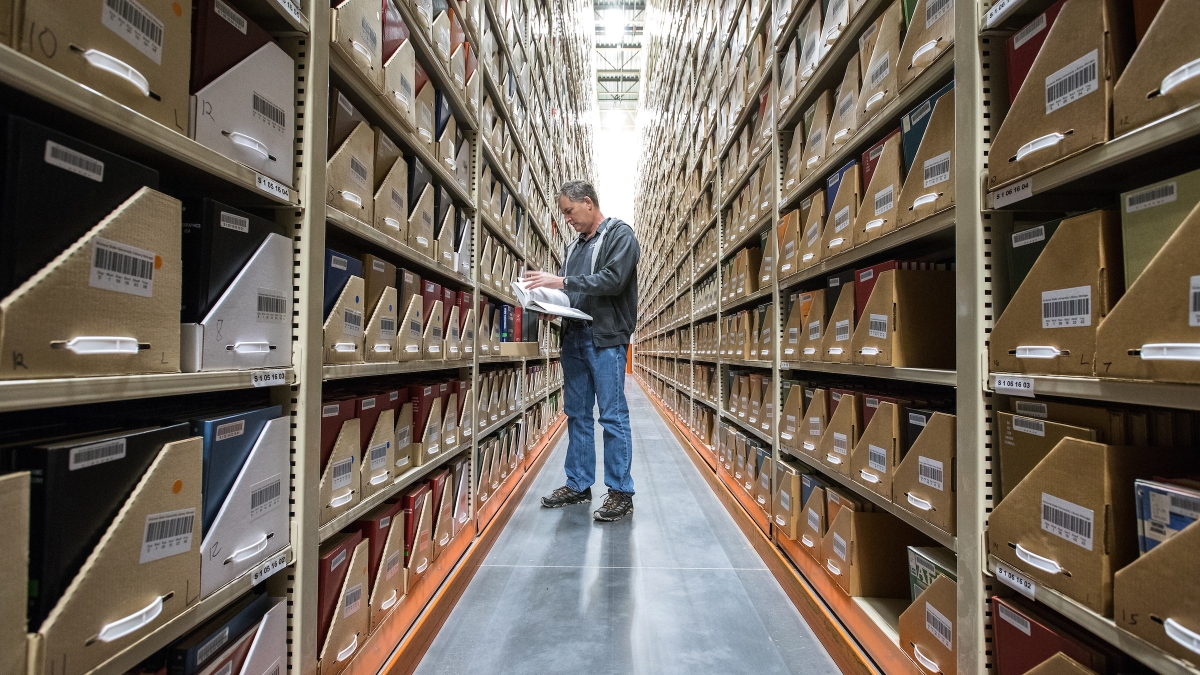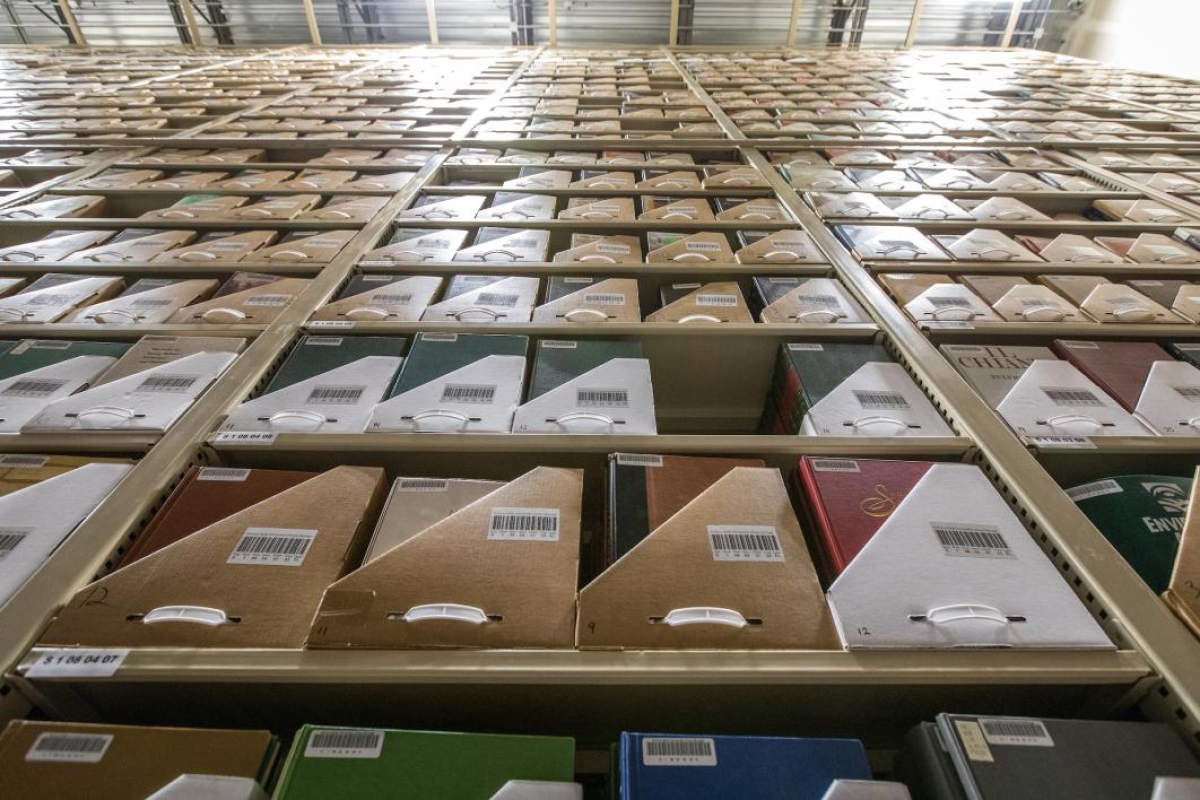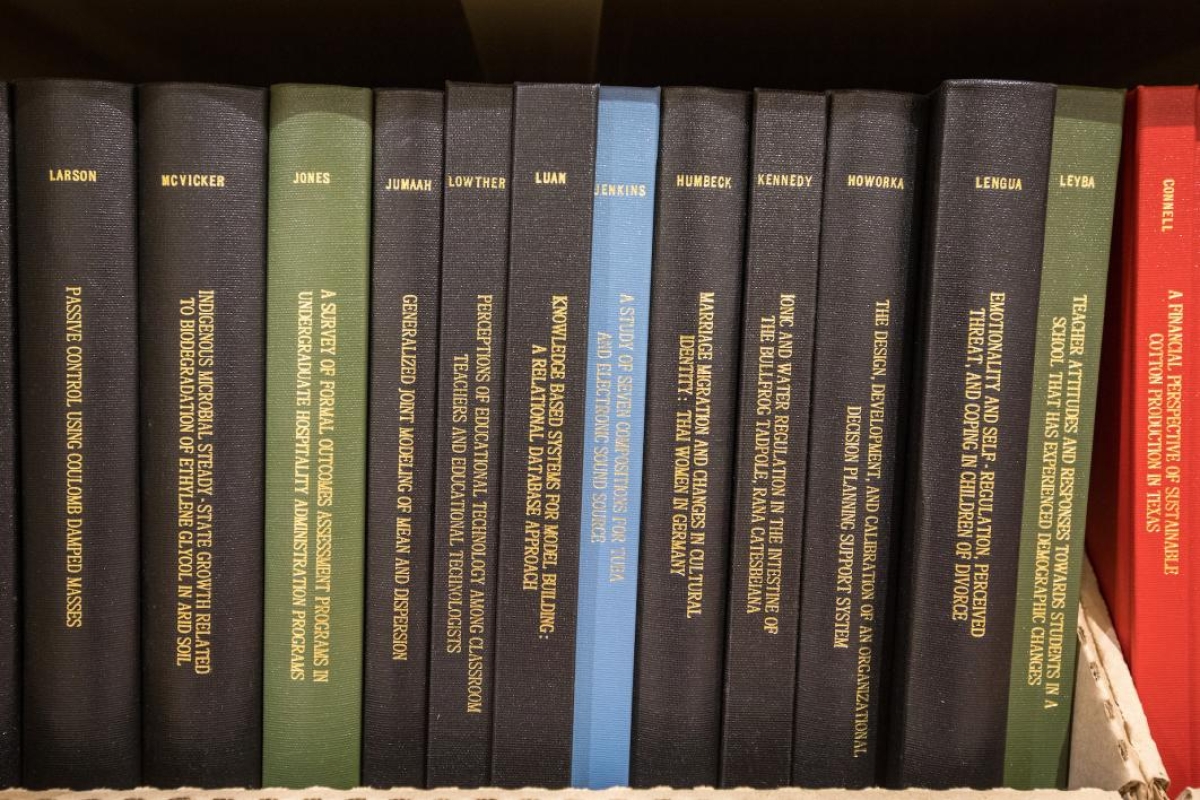Polytechnic archive a paradise for books

Fahrenheit 451 is popularly thought to be the temperature, as Ray Bradbury famously wrote in the epigraph to his eponymous novel, “at which book paper catches fireIt’s actually a range between 440 F and 470 F, depending on who did the study and what type of paper they used., and burns ...”
The temperature at which books do their best, however, is 50 degrees Fahrenheit. At that temperature, with humidity of 30 percent, books will live for 200 years.
Those are the conditions in Arizona State University’s library archives, a paradise for books. An enormous chilly space on the Polytechnic campus, it’s becoming home to more and more of the university’s 4.5 million volumes.
As ASU makes its way through the planning stages for a main library renovation expected to take place in the next few years, the facility is likely to see more action during that time.
Books go back before printing to at least the 6th and 7th centuries BC. (Arguably before that to papyrus scrolls and Mayan codices as well.) However old the form may be, books remain the last word in research. The Internet is a mile wide but an inch deep. Do any serious research, and you’re eventually going to end up in the stacks.
The problem for ASU, and university libraries around the country, is summed up by university librarian Jim O’Donnell: “Everybody has too many books.”
At ASU, the two millionth volume arrived in 1985. Now, the library is at 4.5 million books. The collection is getting too big to manage by eye.
“When you have 4.5 million of them, you’re never going to browse more than a fraction of them,” O’Donnell said.
O’Donnell’s informal motto for the library is borrowed from the famed Harrods department store of London, a motto that is carved on the company’s building in Knightsbridge. It’s Latin, of course: “Omnia omnibus ubique,” or “Everything for everybody, everywhere.”
“I think it’s a pretty good motto for the library, and it’s a good motto for ASU,” O’Donnell said. “No limits, no boundaries — you need it, we’re going to find it for you. We can’t do that right now, but that’s got to be our goal.”
The archives operate like Amazon’s fulfillment center warehouses. Students and faculty who request a book can pick it up at Hayden library on the Tempe campus by 9 a.m. the next day (at the West campus by about 10 a.m.).
“The facility is a means to an end, and a part of a means to a strategy,” O’Donnell said. “It’s emphatically not a place to put books just to get them out of the way.”
'Raiders of the Lost Ark'
Down at the archives, assistant manager of collections maintenance Mark Prestegard looks up at the towering shelves. At 150 deep and 32 feet high, they give new meaning to the word “stacks.”
Video by Ken Fagan/ASU Now
Prestegard and the other staff use an order picker to get to the books. It’s basically a man lift. The staff calls it “Buttercup.”
“Most librarians aren’t able to ride a forklift on the job,” Prestegard said.
Robotic shelving exists, but it would be very expensive to convert to that. The technology is also first-generation. “It’s like a 1930s car,” O’Donnell said. “It’s not like a 1990s Toyota, which will run forever. They’re still working on it, and it’s kind of clunky. ... And what I love about the system is that it can’t break.”
The space Prestegard is standing in holds 1,040,000 volumes. It’s one of three modules, each capable of holding 1.9 million volumes. “The goal is to keep them 200 years,” he said.
In the archives, books are arranged by size, not subject. The arrangement makes for strange bedfellows. “The Rack” by John Frederick Peto, “Corporate Bond Postponements January 1966-June 1966” and “Volcanic Geology of the Interior Valley, San Francisco Mountain, Arizona” all sit on the same shelf.
A courier comes several times a day.
“Every time somebody comes in here — usually if there’s a crowd of people — somebody will mention ‘Raiders of the Lost Ark,’” Prestegard said.
Unlike the Ark of the Covenant, however, nothing gets lost in the archives. All books and boxes are bar-coded. Nothing gets lost, and nothing gets reshelved improperly.
“In fact, we find lost books and we improve the quality of the data,” O’Donnell said. “A closed stack is safer and more reliable than an open stack.”
There is a lot of pressure on the central library. Hayden gets 10,000 to 15,000 visitors per day. Noble Science Library sees 7,000 to 10,000 per day. On a busy day, both libraries will have 25,000 visitors.
“We’ve got something they want,” O’Donnell said.
Using existing facilities on campus for the maximum benefit of a very large number of people puts pressure on a central library.
“We need to think about who those people are, what they do when they get here, and what supports their success to maximum effect,” O’Donnell said.
Who they are tend to be overwhelmingly online users. Even students who come in to the library are on their laptops. And because laptops have a disturbing tendency to disappear when they’re untended, those students use online chat with librarians even while sitting in the building.
“They are to that extent online users,” O’Donnell said.
The traditional stacks are thinly used, underpopulated and do not justify the amount of space for the number of users.
Faculty are in the same boat. It’s a big campus and a spread-out university. They mainly send research assistants to pick up books they ordered online.
“When my office was on the main floor of Hayden, most of the books I need for my own academic work are on the main floor of Hayden,” O’Donnell said. “I would order them on the computer and pick them up downstairs 50 yards away the next morning because it was just easier, even when I’m right there.”
About 60,000 students are on the Tempe campus.
“Hayden is a privileged and glorious place for them, and a distant glimmer for everybody else,” he said. “And everybody else is growing fast.”
Virtual browsing
Hayden’s stacks of 2.5 million will be shrunk to about 350,000 after the tower is renovated, with the culled books sent to the Polytechnic archive.
“We’re working on which 350,000 books to keep,” O’Donnell said. “It won’t be the greatest hits, but instead books that will be of most value to users and will provoke interest in undergrads to think about the world in ways they did not think about before.”
Making sure the library has enough copies of popular literature like “Moby Dick” or “Pride and Prejudice” is meaningless today. If you wanted to read “Moby Dick,” you could pull up the whole book on whatever gadget you’re reading this on now in about 30 seconds. You could do it sitting on a mountaintop in Tibet if the Wi-Fi was good enough.
“I’m not sure whether we need ‘Moby Dick’ in the new library or not,” O’Donnell said. “At the very least, we don’t need 20 copies. ... Having really good provocative research you don’t find anywhere else, that’s more interesting. That’s something to put in front of an eager 19-year-old. ... That’s where we’re going. That’s ASU’s library.”
The subjective power of browsing will go away to some extent, but virtual browsing will replace it.
“It’ll be in some respects better than this,” O’Donnell said.
Suppose you get a hunger to learn about Tibetan history. You go to Hayden and find the Tibetan history shelf. There’s one book on the topic that every source says is the definitive general work — and of course it has been checked out. The best thing you find is the 1885 history. It’s missing a century, including the Chinese invasion and the Tibetan diaspora.
You will turn to a web portal that will show you everything ASU has (and how long it will take to get to you); then, at a click, everything in 32 university libraries between the Mississippi and the Pacific, and then, at another click, everything available nationally.
“Bear in mind, the Starbucks barista in Holyoke, Massachusetts, who is getting her college degree doesn’t get to go stand in Hayden,” O’Donnell said. “For her, the virtual online browse is going to be 1,000 percent better.”
Virtual browsing will not be quite like Amazon’s “Look Inside the book” feature (that technology is proprietary), but whatever digital content the university has access to (full text for pre-1923 Google books, tables of contents for many recent books, full catalog records, images of dust jackets, etc.) will be there for you. As time passes, the service will constantly improve. Another bonus is that browsing will include books that are currently checked out — something the traditional shelf has never been able to show except by glaring gaps.
Usually when libraries shrink their collections, the tendency is to hold on to the best sellers, the most-checked-out and other popular volumes. ASU is going a more sophisticated route.
“We’re saying, ‘Let’s show them the funky weird stuff, even stuff they wouldn’t check out or be able to check out, but at least they now know the funky weird stuff exists,’” O’Donnell said. “Smart, ambitious young people can get to do something like that, rather than just see John Grisham and Danielle Steel.
“I’m not even sure if we have John Grisham or Danielle Steel, and I don’t care. If you need that, you can take care of that. You need Albanian history. You need meat. You come to a university to say, ‘That would be interesting,’ and do something with it. When that happens, we succeed.”




